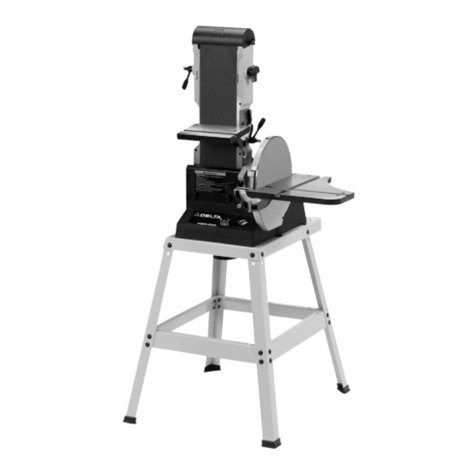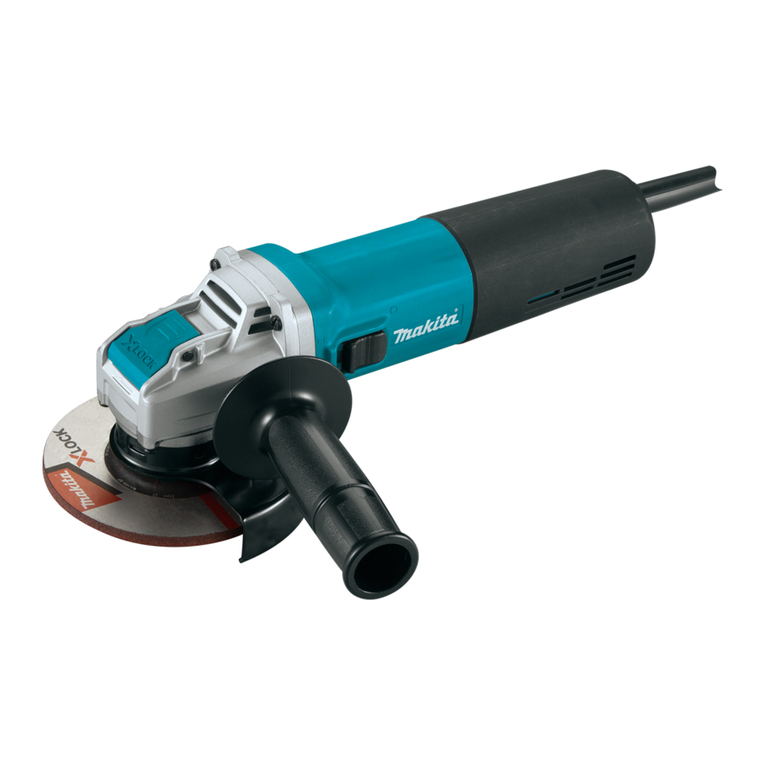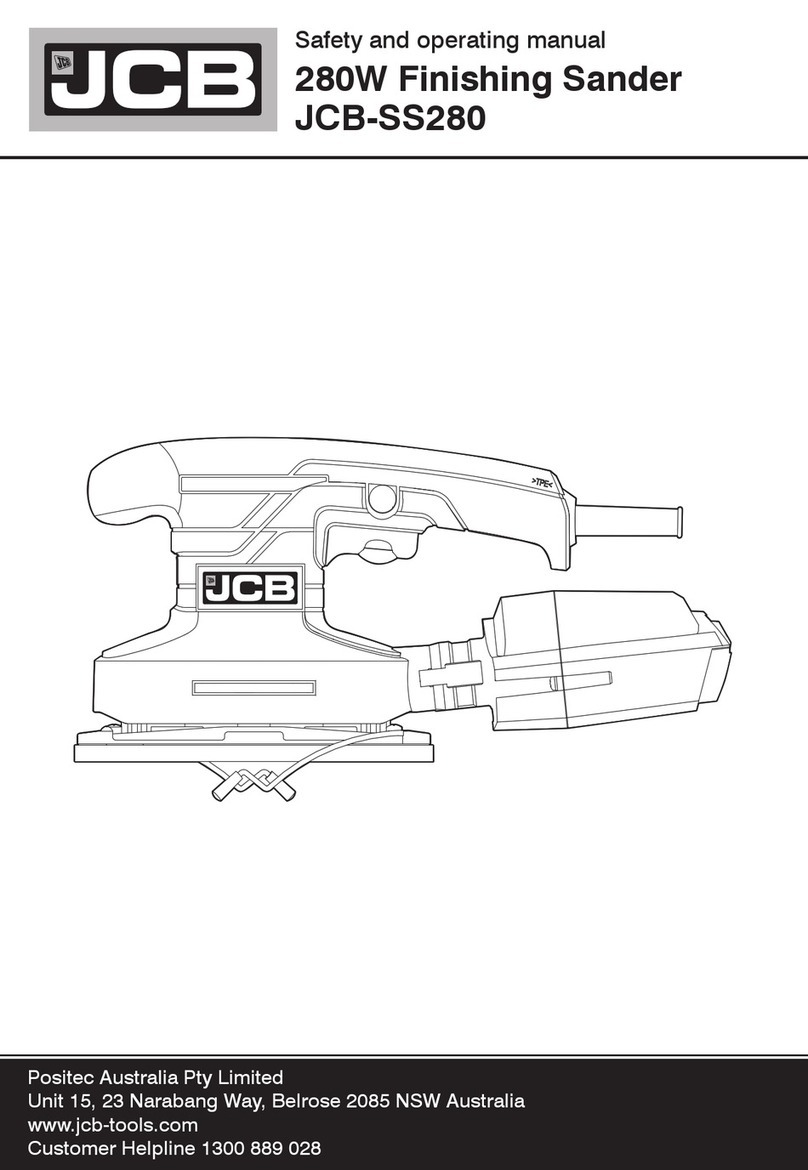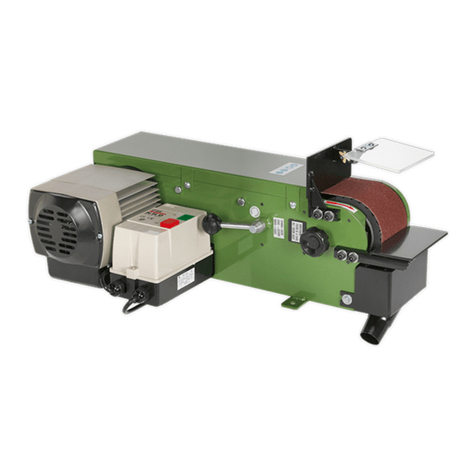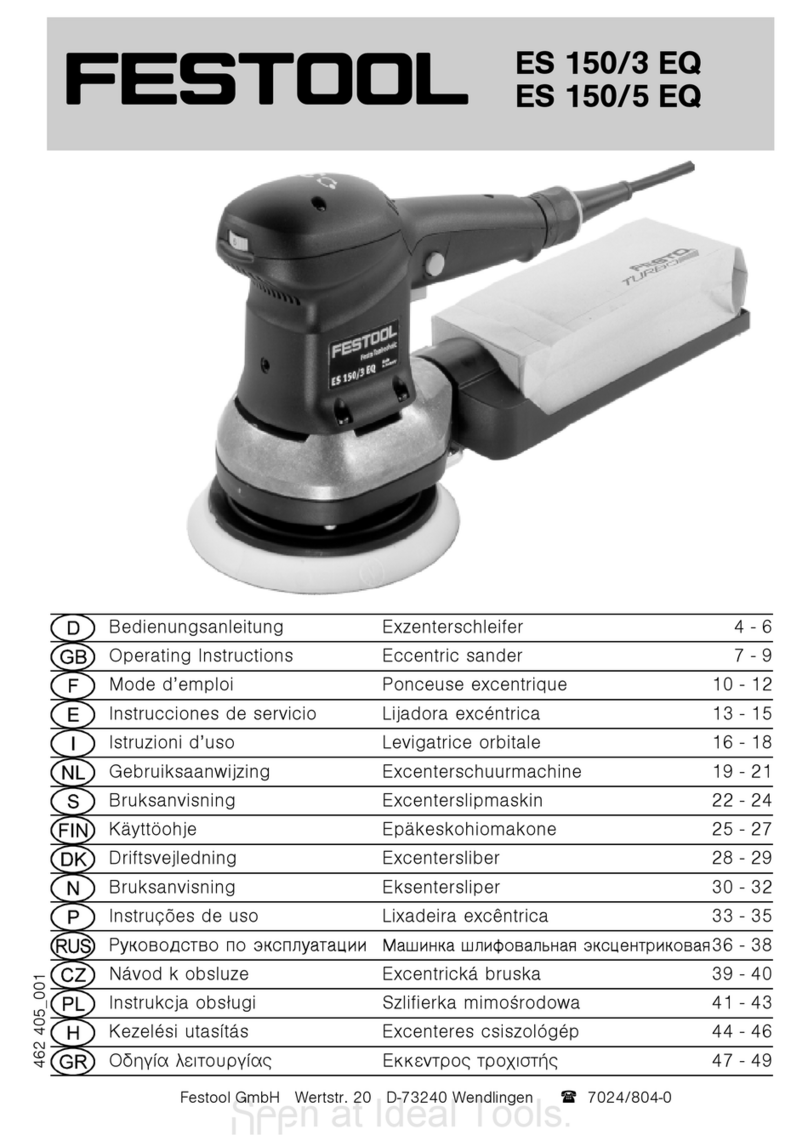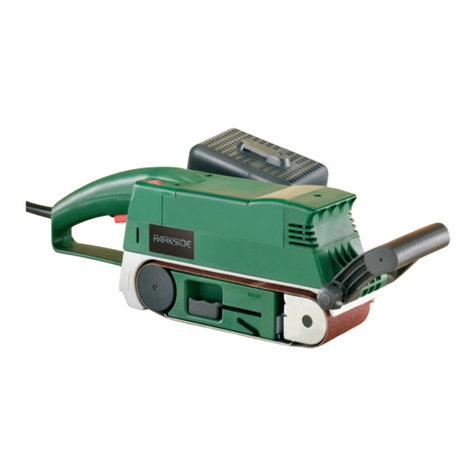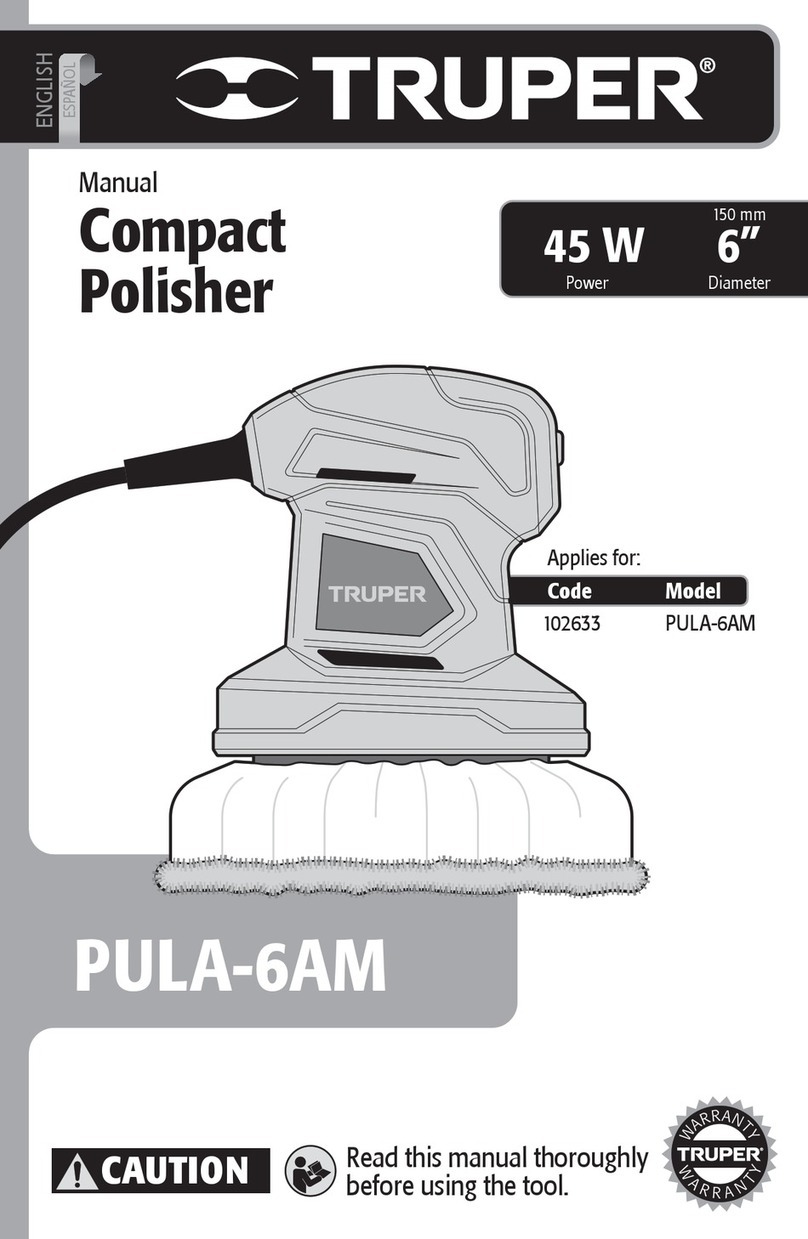Shopseries RK7866 User manual

RK7866
4˝ BELT / 6˝ DISC SANDER PAGE 6 ENG
LIJADORA DE CINTA DE 4PULG. / DISCO DE 6PULG. PAGE 13 ESP
COURROIE 4 PO / PONCEUSE À DISQUE 6 PO PAGE 21 FRE

Thank you for purchasing a SHOPSERIES®power tool. We are confident that you will appreciate
the quality of the product and you will be entirely satisfied with your purchase. Please read
carefully the user safety and operating instructions on how to operate this product correctly
within safety norms and regulations.
Gracias por su compra de un producto SHOPSERIES®. Estamos seguros de que apreciará
la calidad del producto y de que estará completamente satisfecho con su compra. Lea
cuidadosamente las instrucciones de seguridad y de operación para obtener mayor información
acerca de cómo utilizar éste producto correctamente dentro de las normas y reglas de
seguridad.
Merci d’avoir choisi un produit de marque SHOPSERIES®. Nous sommes certains que ous
apprécierez la qualité de ce produit et qu’il saura vous satisfaire. Pour être renseigné sur toutes
les méthodes de travail correctes et sécuritaires répondant aux normes et règlements de
sécurité, veuillez lire attentivement la notice de sécurité et de fonctionnement présentée.

RK7866
1
2
3
4
5
10
11
12 1413
12
9
8
15
16
17
18
19
6 7

F2
GH
J
M2
K
AB1
C
E1 E2
D1
D2
B3
B2
D3
I
M1
6
17
3
a
b
2 10
13
F1

F2
GH
J
M2
K
AB1
C
E1 E2
D1
D2
B3
B2
D3
I
M1
6
17
3
a
b
2 10
13
F1

4˝ BELT / 6˝ DISC SANDER ENG
6
COMPONENT LIST
WORK SUPPORT
BELT TENSION LEVER
SANDING PLATE
MITER GAUGE LOCKING KNOB
MITER GAUGE
SANDING DISC
ON/OFF SWITCH
BASE
MOUNTING HOLE
BELT TRACKING ADJUSTING KNOB
BELT BED
SANDING BELT
WORK SUPPORT HEX SCREW
BELT BED LOCKING SCREW
SANDING DRUM GUARD
WORKTABLE
WORKTABLE LOCKING KNOB
BEVEL GAUGE
DUST EXTRACTION OUTLET
* Not all the accessories illustrated or described are included in standard delivery.
1
2
3
4
5
6
7
15
8
16
9
17
10
18
11
19
12
13
14

7
4˝ BELT / 6˝ DISC SANDER ENG
ACCESSORIES
45oMiter gauge 1
Allen key 1
Sanding belt 1
Sanding disc 1
We recommend that you purchase your accessories
from the same store that sold you the tool. Use good
quality accessories marked with a well-known brand
name. Choose the type according to the work you
intend to undertake. Refer to the accessory packaging
for further details. Store personnel can assist you and
offer advice.
READ ALL INSTRUCTIONS BEFORE
USING THIS APPLIANCE
INSTRUCTIONS PERTAINING TO A RISK OF INJURY
GENERAL
A. GROUNDING INSTRUCTIONS
1. All grounded, cord-connected tools:
In the event of a malfunction or breakdown,
grounding provides a path of least resistance
for electric current to reduce the risk of electric
shock. This tool is equipped with an electric cord
having an equipment-grounding conductor and
a grounding plug. The plug must be plugged into
a matching outlet that is properly installed and
grounded in accordance with all local codes and
ordinances.
Do not modify the plug provided – if it will not t
the outlet, have the proper outlet installed by a
qualied electrician.
Improper connection of the equipment-
grounding conductor can result in a risk of
electric shock. The conductor with insulation
having an outer surface that is green with
or without yellow stripes is the equipment-
grounding conductor. If repair or replacement
of the electric cord or plug is necessary, do not
connect the equipment-grounding conductor to a
live terminal.
Check with a qualied electrician or service
personnel if the grounding instructions are
not completely understood, or if in doubt as to
whether the tool is properly grounded.
Use only 3-wire extension cords that have
3-prong grounding plugs and 3-pole receptacles
that accept the tool’s plug.
Repair or replace damaged or worn cord
immediately.
2. Grounded, cord-connected tools intended for use
on a supply circuit having a nominal rating less
than 150V:
This tool is intended for use on a circuit that has
an outlet that looks like the one illustrated in
Sketch A in Figure 1. The tool has a grounding plug
that looks like the plug illustrated in Sketch A in
Figure 1. A temporary adapter, which looks like the
adapter illustrated in Sketches B and C, may be
used to connect this plug to a 2-pole receptacle
as shown in Sketch B if a properly grounded outlet
is not available. The temporary adapter should
be used only until a properly grounded outlet can
be installed by a qualied electrician. The green-
colored rigid ear, lug and the like, extending from
the adapter must be connected to a permanent
ground such as a properly grounded outlet box.
3. Grounded, cord-connected tools intended for
use on a supply circuit having a nominal rating
between 150-250V, inclusive:
This tool is intended for use on a circuit that
has an outlet that looks like the one illustrated
in Sketch D in Figure 1. The tool has a grounding
plug that looks like the plug illustrated in Sketch
D in Figure 1. Make sure the tool is connected to
an outlet having the same conguration as the
plug. No adapter is available or should be used
with this tool. If the tool must be reconnected
for use on a different type of electric circuit,
the reconnection should be made by qualied
service personnel; and after reconnection, the
tool should comply with all local codes and
ordinances.
4. Permanently connected tools:
This tool should be connected to a grounded
metal permanent wiring system; or to a system
having an equipment-grounding conductor.
B. FOR ALL DOUBLE-INSULATED TOOLS
1. Replacement parts
When servicing use only identical replacement
parts.
2. Polarized Plugs
To reduce the risk of electric shock, this
equipment has a polarized plug (one blade
is wider than the other). This plug will t in a
polarized outlet only one way. If the plug does
not t fully in the outlet, reverse the plug. If it still

4˝ BELT / 6˝ DISC SANDER ENG
8
does not t, contact a qualied electrician to
install the proper outlet. Do not change the plug in
any way.
C. FOR ALL TOOLS AS APPLICABLE
1. KEEP GUARDS IN PLACE and in working order.
2. REMOVE ADJUSTING KEYS AND WRENCHES. Form
habit of checking to see that keys and adjusting
wrenches are removed from tool before turning it
on.
3. KEEP WORK AREA CLEAN. Cluttered areas and
benches invite accidents.
4. DON’T USE IN DANGEPOUS ENVIRONMENT. Don’t use
power tools in damp or wet locations, or expose
them to rain. Keep work area well lighted.
5. KEEP CHILDREN AWAY. All visitors should be kept
safe distance from work area.
6. MAKE WORKSHOP KID PROOF with padlocks,
master switches, or by removing starter keys.
7. DON’T FORCE TOOL. It will do the job better and
safer at the rate for which it was designed.
8. USE RIGHT TOOL. Don’t force tool or attachment to
do a job for which it was not designed.
9. USE PROPER EXTENSION CORD. Make sure your
extension cord is in good condition. When using
an extension cord, be sure to use one heavy
enough to carry the current your product will
draw. An undersized cord will cause a drop
in line voltage resulting in loss of power and
overheating. Table 1 shows the correct size to use
depending on cord length and nameplate ampere
rating. If in doubt, use the next heavier gage. The
smaller the gage number, the heavier the cord.
10. WEAR PROPER APPAREL. Do not wear loose
clothing, gloves, neckties, rings, bracelets, or
other jewelry which may get caught in moving
parts. Nonslip footwear is recommended. Wear
protective hair covering to contain long hair.
11. ALWAYS USE SAFETY GLASSES. Also use face or
dust mask if cutting operation is dusty. Everyday
eyeglasses only have impact resistant lenses,
they are NOT safety glasses.
12. SECURE WORK. Use clamps or a vise to hold work
when practical. It’s safer than using your hand
and it frees both hands to operate tool.
13. DON’T OVERREACH. Keep proper footing and
balance at all times.
14. MAINTAIN TOOLS WITH CARE. Keep tools sharp
and clean for best and safest performance.
Follow instructions for lubricating and changing
accessories.
15. DISCONNECT TOOLS before servicing; when
changing accessories, such as blades, bits,
cutters, and the like.
16. REDUCE THE RISK OF UNINTENTIONAL STARTING.
Make sure switch is in off position before
plugging in.
17. USE RECOMMENDED ACCESSORIES. Consult the
owner’s manual for recommended accessories.
The use of improper accessories may cause risk
of injury to persons.
18. NEVER STAND ON TOOL. Serious injury could
occur if the tool is tipped or if the cutting tool is
unintentionally contacted.
19. CHECK DAMAGED PARTS. before further use of
the tool, a guard or other part that is damaged
should be carefully checked to determine that it
will operate properly and perform its intended
function – check for alignment of moving parts,
binding of moving parts, breakage of parts,
mounting, and any other conditions that may
affect its operation. A guard or other part that
is damaged should be properly repaired or
replaced.
20. DIRECTION OF FEED. Feed work into a blade or
cutter against the direction of rotation of the
blade or cutter only.
21. NEVER LEAVE TOOL RUNNING UNATTENDED. TURN
POWER OFF. Don’t leave tool until it comes to a
complete stop.
Figure 1
Grounding methods
GROUNDING
PIN
ADAPTER
GROUNDING
MEANS
GROUNDING
PIN
METAL SCREW
COVER OF GROUND
OUTLE BOX

9
4˝ BELT / 6˝ DISC SANDER ENG
Table 1
Minimum gage for corda
Ampere
Rating
Volts Total length of cord in feet
120V
240V
25ft.
50ft.
50ft.
100 ft.
100 ft.
200 ft.
150 ft.
300 ft.
More Than
Not More
Than AWG
0
6
10
6
10
12
18
18
16
16
16
16
16
14
14
14
12
12
12 16 14 12
Not Recommended
California proposition 65:
WARNING: This product may contain lead,
phthalate or other chemicals known to the
State of California to cause cancer, birth defects
and other reproductive harm. Wash your hands
after use.
ADDITIONAL SAFETY WARNING FOR
YOUR TOOL
1. For Your Own Safety Read Instruction Manual
Before Operating Tool
a) Wear eye protection.
b) Support workpiece with miter gage, backstop, or
worktable.
c) Maintain 1/16 in maximum clearance between
table and sanding belt or disc.
d) Avoid kickback by sanding in accordance with the
directional arrows.
2. For belt and disc sanders, the sanding belt is
designed to rotate down towards the table
while the disc rotates both up from the table and
down towards the table, and there’s potential
risk of injury to persons if sanding against the
directional arrows on the disc.
SAVE THESE INSTRUCTIONS
Refer to them frequently and use them to instruct others
who may use this tool. If someone borrows this tool,
make sure they have these instructions.
WARNING! Some dust created by power
sanding, sawing, grinding, drilling and other
construction activities contains chemicals known
to cause cancer, birth defects or other reproductive
harm. Some examples of these chemicals are:
1) lead from lead-based paint
2) crystalline silica from bricks and cement and other
masonry products
3) arsenic and chromium from chemically-treated
lumber
Your risk to these exposures varies, depending on how
often you do this type of work. To reduce your exposure
to these chemicals:
1) work in a well ventilated area
2) work with approved safety equipment, such as those
dust masks that are specically designed to lter out
microscopic particles.
Avoid prolonged contact with dust from power
sanding, sawing, grinding, drilling and other
construction activities. Wear protective clothing and
wash exposed areas with soap and water. Allowing
dust to get into your mouth, eyes, or lay on the skin
may promote absorption of harmful chemicals.
WARNING: Use of this tool can generate and/
or disburse dust, which may cause serious
and permanent respiratory or other injury. Always
use NIOSH/OSHA approved respiratory protection
appropriate for the dust exposure. Direct particles
away from face and body.

4˝ BELT / 6˝ DISC SANDER ENG
10
SYMBOLS
Read the manual
Warning
Wear ear protection
Wear eye protection
Wear dust mask
noNo-load speed
TECHNICAL DATA
Voltage 120V~60Hz
Amps 4.3A
Belt length 4˝ x 36˝
Belt table tilt range 0O/90O
Belt speed 1700fpm
Disc size 6˝
Disc speed 3600/min
Table size 8-29/32˝ x 6-5/16˝
Table tilt range 0-45O
Weight: 42lbs
OPERATING INSTRUCTIONS
NOTE: Before using the tool, read the instruction
book carefully.
ASSEMBLY
WARNING: Remove the plug from the socket
before carrying out any adjustment,
servicing or maintenance.
1. MOUNTING THE BELT/DISC SANDER TO WORKBENCH
(SEE FIG.A)
If belt/disc sander is to be used in a permanent location,
it should be fastened securely to a rm supporting
surface such as a workbench.
If mounting to a workbench, holes should be drilled
through supporting surface of the workbench.
1) The unit should be bolted securely using M8 screws
and hex nuts (not provided). Screw length should be
about 1.5” plus the thickness of the bench top.
2) Locate and mark the holes where belt/disc sander is
to be mounted.
3) Drill 2 holes of 0.4” diameter though workbench.
4) Place belt/disc sander on workbench aligning holes
drilled in workbench.
5) Insert two M8 screws and tighten hex nuts.
2. ASSEMBLING SANDING DISC AND GUARD (SEE FIG.
B1-B3)
1) Remove the backing from the sanding disc (6). Align
perimeter of disc with sanding plate (3) and press disc
rmly into position all the way around.
2) Locate disc guard (a) and two M4.2 pan head screws.
3) Position disc guard against lower 1/3 of disc, aligning
holes.
4) Using a Phillips screwdriver, fasten the pan head

11
4˝ BELT / 6˝ DISC SANDER ENG
screws securely, applying light pressure to thread the
holes.
3. INSTALLING WORK SUPPORT (SEE FIG.C)
1) Adjust the work support hex screw (13) on side of
belt/disc sander by using an allen key.
2) Hold work support in position and fasten.
4. MOUNTING THE WORKTABLE (SEE FIG.D1-D3)
1) Position the table support (b) against worktable and
align the holes.
2) Using 3 M6 hex screws, 3 lock washers and 3 at
washers fasten the table support to the work table.
3) Position the table support in the corresponding holes
on the side of the base. Ensure that the 0.4” (9.5 mm)
diameter index pin aligns with the upper hole.
4) Place the washer on the end of the worktable locking
knob (17) threaded shaft and insert shaft through the
slot and into the threaded hole of base.
WARNING: To avoid trapping the work or ngers
between the table and sanding surface, the
table edge should be a maximum of 0.08” (2 mm) from
sanding surface.
5) Loosen the 3 hex head screws at bottom of table
support and adjust table as required. Adjust table as
necessary and retighten screws.
ADJUSTMENT
WARNING: Remove the plug from the socket
before carrying out any adjustment, servicing or
maintenance.
1. INSTALLING/ADJUSTING THE SANDING BELT (SEE FIG.
E1, E2)
On the smooth side of the sanding belt, you will nd
a”directional arrow”. The sanding belt must run in the
direction of this arrow, so that the splice does not come
apart.
1) Pull the belt tension lever (2) to right to release the
belt tension.
2) Place the sanding belt (12) over the drums with the
directional arrow pointing towards the left hand side.
Make sure the belt is centered on both drums.
3) Slide tension lever to left to apply belt tension.
4) Tighten the belt bed locking screw (14) when the bed
is in desired position.
5) Plug in the power cord. Turn switch “On” and
immediately “OFF”, noting if the belt tends to slide off
the idler drum or drive drum. If it did not tend to slide off
it is TRACKING properly.
6) If the sanding belt moves toward the disc, turn the
tracking adjusting knob (10) counterclockwise 1/4 turn.
7) If the sanding belt moves away from the disc, turn the
tracking knob anticlockwise 1/4 turn.
8) Turn switch “ON” and immediately “OFF” noting belt
movement. Re-adjust tracking knob if necessary.
2. POSITIONING THE BELT BED (SEE FIG.F1, F2)
The belt bed locking screw locks the belt bed in a
vertical or horizontal position.
To adjust vertical position:
1) Remove work support.
2) Loosen the belt bed locking screw by using an allen
key.
3) Position the belt bed and retighten the hex locking
screw.
OPERATION
1. SWITCH ON/OFF (SEE FIG.G)
To turn the machine on, move the switch to the “ON”
position. To turn it off, move the switch to the “OFF”
position.
To “Lock-off” the machine:
When the machine is not in use and to prevent
unauthorized use, the switch should be locked in the
“OFF” position. To do this, pull the locking key out of
the ON/OFF switch and store the key in a secure place.
With the key removed, the switch will not operate.
2. BEVEL SANDING (SEE FIG.H)
1) The worktable can be tilted from 0oto 45ofor bevel
sanding.
2) Loosen the worktable locking knob and tilt the
worktable to the desired angle.
3) Retighten the worktable locking knob.
WARNING: To avoid trapping the work or ngers
between the table and sanding surface, the table
should be repositioned on the table support to retain
a maximum of 0.08” (2 mm) distance between sanding
surface and table.
3. MITER SANDING (SEE FIG.I)
1) Use of the miter gauge is recommended for this
operation.
2) Rest the workpiece against the edge of the miter
gauge.
3) Always move the work across the left hand side of the
sanding disc.
4) The table may be tilted for beveled work.

4˝ BELT / 6˝ DISC SANDER ENG
12
4. VERTICAL SANDING (SEE FIG.J)
1) Loosen the belt bed locking screw and raise the
belt bed to the vertical position. Retighten the belt bed
locking screw. (See Fig.F1)
2) Tighten the work support hex screw (13), and hold the
work support in position and fasten. (See Fig.C)
3) Then your machine can sand vertically. (See Fig.J)
5. SURFACE SANDING ON THE SANDING BELT (SEE FIG.K)
When checking clearance between the belt and work
support, press the belt at against the metal beneath it.
1) Hold the workpiece rmly with both hands, keeping
ngers away from the sanding belt.
2) Keep the end butted against the backstop and move
the work evenly across the sanding belt. Use extra
caution when sanding very thin pieces.
3) When sanding long pieces, remove the work support.
4) Apply only enough pressure to allow the sanding belt
to remove any material.
6. SANDING CURVED EDGES
1) Always sand inside curves on idler drum as shown.
(See Fig.M1)
WARNING: Never attempt to sand the ends of a
workpiece on the idler drum. Applying the end
of the workpiece to the idler drum could cause the work
piece to y up and result in an injury.
2) Always sand outside curves on the left hand side of
the sanding disc. (See Fig.M2)
WARNING: Applying the workpiece to the right
side of the disc could cause workpiece to y up
(kickback) and result in injury.
MAINTAIN TOOLS WITH CARE
Remove the plug from the socket before carrying out
any adjustment, servicing or maintenance.
There are no user serviceable parts in your power
tool. Never use water or chemical cleaners to clean
your power tool. Wipe clean with a dry cloth. Always
store your power tool in a dry place. Keep the motor
ventilation slots clean. Keep all working controls free of
dust. If you see some sparks ashing in the ventilation
slots, this is normal and will not damage your power
tool.
If the supply cord is damaged, it must be replaced
by a special cord or assembly available from the
manufacturer or its service agent.

13
LIJADORA DE CINTA DE 4PULG. / DISCO DE 6PULG. ESP
LISTA DE PARTES
SOPORTE DE LA PIEZA DE TRABAJO
CONTROL DE LA TENSIÓN DE LA CINTA
PLACA DE LIJADO
PERILLA DE BLOQUEO DEL CALIBRADOR DE INGLETE
ESCALA DE INGLETE
DISCO DE LIJA
INTERRUPTOR ENCENDIDO/APAGADO
BASE
AGUJEROS DE MONTAJE
PERILLA DE AJUSTE DEL RECORRIDO DE LA CINTA
SOPORTE DE LA CINTA
CINTA LIJADORA
TORNILLO HEXAGONAL DE APOYO DE LA PIEZA DE TRABAJO
TORNILLO DE BLOQUEO DEL SOPORTE DE LA CINTA
GUARDA TIPO CILINDRO DE LIJADO
MESA
PERILLA DE AJUSTE DE LA MESA DE TRABAJO
ESCALA DE BISELADO
ADAPTADOR PARA ASPIRADORA
No todos los accesorios ilustrados o descritos se incluyen junto con el producto estándar.
1
2
3
4
5
6
7
15
8
16
9
17
10
18
11
19
12
13
14

LIJADORA DE CINTA DE 4PULG. / DISCO DE 6PULG. ESP
14
ACCESSORIES
45oEscala de inglete 1
Llave allen 1
Cinta lijadora 1
Disco de lija 1
Le recomendamos que compre todos los accesorios en
la tienda donde adquirió la herramienta. Use accesorios
de buena calidad una marca bien conocida. Seleccione
los que más convengan al trabajo que intenta hacer.
Consulte el empaque de los accesorios para obtener
más detalles. El personal de la tienda también puede
ayudarle y aconsejarle.
LEA Y COMPRENDA TODAS LAS
INSTRUCCIONES
CONSERVE ESTAS INSTRUCCIONES
INSTRUCCIONES DE SEGURIDAD
A. INSTRUCCIONES DE CONEXIÓN A TIERRA
1. Todas las máquinas conectadas con cordón a
tierra:
En caso de mal funcionamiento o avería, la
conexión a tierra proporciona una ruta de
resistencia mínima para la corriente eléctrica,
con el n de reducir el riesgo de descargas
eléctrica. Esta máquina está equipada con un
cordón eléctrico que tiene un conductor de
conexión a tierra del equipo y un enchufe de
conexión a tierra. El enchufe debe enchufarse en
un tomacorriente coincidente que esté instalado
y conectado a tierra adecuadamente, de acuerdo
con todos los códigos y ordenanzas locales.
No modique el enchufe suministrado.
Si el enchufe no cabe en el tomacorriente,
haga que un electricista calicado instale el
tomacorriente apropiado.
La conexión inapropiada del conductor de
conexión a tierra del equipo puede dar como
resultado riesgo de descargas eléctricas.
El conductor con aislamiento que tiene una
supercie exterior de color verde con o sin
franjas amarillas es el conductor de conexión
a tierra del equipo. Si es necesario reparar o
reemplazar el cordón eléctrico o el enchufe, no
conecte el conductor de conexión a tierra del
equipo a un terminal con corriente.
Consulte a un electricista competente o a
personal de servicio calicado si no entiende
completamente las instrucciones de conexión a
tierra o si tiene dudas en cuanto a si la máquina
está conectada a tierra apropiadamente.
Utilice únicamente cordones de extensión de tres
alambres que tengan enchufes de tipo conexión
a tierra con tres terminales y receptáculos de
tres conductores que acepten el enchufe de la
maquina.
Repare o reemplace inmediatamente los
cordones dañados o desgastados.
2. Máquinas conectadas con cordón conectadas a
tierra diseñadas para utilizarse en un circuito de
alimentación que tenga una capacidad nominal
de menos de 150 V:
Si la máquina está diseñada para utilizarse en
un circuito que tenga un tomacorriente parecido
al que se ilustra en la A Fig1, la máquina tendrá
un enchufe de conexión a tierra que se parece al
enchufe ilustrado en la A Fig 1. Puede utilizarse
un adaptador temporal, que se parece al
adaptador ilustrado en la B&C, para conectar este
enchufe a un receptáculo coincidente de dos
conductores, tal como se muestra en la B, si no se
dispone de un tomacorriente conectado a tierra
apropiadamente. El adaptador temporal debe
utilizarse solamente hasta que un electricista
calicado pueda instalar un tomacorriente
conectado a tierra apropiadamente. La
orejeta, lengüeta, etc., rígida de color verde
que sobresale del adaptador debe conectarse
a una toma de tierra permanente, como por
ejemplo una caja tomacorriente conectada a
tierra adecuadamente. Siempre que se utilice
un adaptador, debe sujetarse en su siton con un
tornillo de metal.
3. Herramientas con conexión a tierra y
alimentación por cable destinadas al uso en un
circuito de alimentación con un voltaje nominal
de 150 - 250 V, ambos inclusive:
Si la máquina está diseñada para utilizarse en
un circuito que tenga un tomacorriente parecido
al que se ilustra en la D Fig1, la máquina tendrá
un enchufe de conexión a tierra que se parece
al enchufe ilustrado en la D Fig 1. Asegúrese de
que la herramienta se encuentra conectada a
una toma de suministro eléctrico que tenga la
misma conguración que el enchufe. No existe
ningún adaptador disponible, ni deberá utilizarse
ninguno para conectar esta herramienta. Si

15
LIJADORA DE CINTA DE 4PULG. / DISCO DE 6PULG. ESP
es necesario volver a conectar la herramienta
para utilizarla con un tipo diferente de circuito
eléctrico, la nueva conexión deberá ser realizada
por personal técnico cualicado; una vez
realizada la nueva conexión, la herramienta
deberá satisfacer todas las normativas y
ordenanzas locales.
4. Herramientas continuamente conectadas:
Esta herramienta debe ser conectada a un
sistema de cableado de metal permanente y con
descarga a tierra o a un sistema que posea un
conductor de puesta a tierra de equipos.
B. PARA TODAS LAS HERRAMIENTAS CON DOBLE
AISLAMIENTO
1. Piezas de repuesto
Deben utilizarse únicamente piezas idénticas
durante las operaciones de reparación.
2. Enchufes polarizados
Las herramientas con doble aislamiento están
equipadas con un enchufe polarizado (una pata
es más ancha que la otra). Este enchufe entrará
en un tomacorriente polarizado solamente de
una manera. Si el enchufe no entra por completo
en el tomacorriente, délo vuelta. Si sigue sin
entrar, póngase en contacto con un electricista
competente para instalar un tomacorriente
polarizado. No haga ningún tipo de cambio en el
enchufe.
C. PARA TODAS LAS HERRAMIENTAS, SEGÚN SEA
PERTINENTE
1. Mantenga las guardas en su lugar y en perfecto
estado de funcionamiento.
2. Retire las llaves de ajuste. Asegúrese de
comprobar siempre que las llaves de ajuste no se
encuentren en lugar de la herramienta antes de
encenderla.
3. Mantenga limpia el área de trabajo. Las áreas de
trabajo y bancos desordenados podrían causar
accidentes.
4. No utilice la herramienta. No utilice la
herramienta motorizada en ambientes húmedos
o mojados o expóngala a la lluvia. Mantenga bien
iluminada el área de trabajo.
5. Mantenga a los niños alejados de la herramienta.
Todas las visitas deben mantener una distancia
apropiada del área de trabajo.
6. Asegúrese de que el taller sea seguro para
los niños utilizando candados, interruptores
generales o retirando las llaves de encendido.
7. No fuerce a la herramienta. Ésta realizará el
trabajo para el cual fue diseñado mejor y de
manera más segura.
8. Utilice la herramienta adecuada. No utilice una
herramienta o un accesorio para realizar un
trabajo para el cual no fue diseñado.
9. Utilice cables de extensión apropiados.
Cerciórese de que su cable prolongador esté
en buenas condiciones. Asegúrese de utilizar
un prolongador lo sucientemente resistente
como para soportar la corriente que requiere su
producto. Un cable pequeño causará una caída
de corriente en la línea de voltaje, dando por
resultado recalentamiento y pérdida de potencia.
La Tabla 1 muestra el calibre correcto a utilizar,
dependiendo de la longitud del cable y del
amperaje indicado en la placa de identicación.
En caso de duda, utilice el tamaño mayor
siguiente. Cuanto menor es el calibre, mayor es la
capacidad del cable.
10. Vístase apropiadamente. No se ponga ropa
holgada ni joyas. Recójase el cabello largo.
Mantenga su cabello, ropa y guantes alejados
de las piezas móviles. Se recomienda utilizar
un calzado antideslizante. Utilice una gorra de
protección para colocar el cabello largo dentro
de ésta.
11. Utilice siempre anteojos de seguridad. También
utilice una máscara facial o una máscara
antipolvo si la operación de corte es polvorienta.
Los anteojos comunes sólo poseen lentes
resistentes a los impactos y NO pueden ser
considerados como anteojos de seguridad.
12. Asegure la pieza de trabajo. Utilice abrazaderas
o un tornillo de banco para asegurar la pieza
de trabajo cuando sea necesario. Esto es más
seguro debido a que permite usar ambas manos
para utilizar la herramienta.
13. No intente alcanzar demasiado lejos. Mantenga
un apoyo de los pies y un equilibrio adecuados en
todo momento.
14. Realice con cuidado el mantenimiento de las
herramientas. Mantenga las herramientas
limpias con el n de lograr el mejor rendimiento
y el más seguro. Siga las instrucciones de
lubricación de las herramientas y de cambio de
accesorios.
15. Desconecte el enchufe de la fuente de
alimentación antes de hacer cualquier ajuste,
cambiar accesorios o guardar la herramienta.
16. Reduzca el riesgo de un encendido accidental.

LIJADORA DE CINTA DE 4PULG. / DISCO DE 6PULG. ESP
16
Asegúrese de que el interruptor se encuentre
en la posición de apagado antes de enchufar la
herramienta.
17. Utilice los accesorios recomendados. Consulte
el manual de usuario para obtener información
acerca de los accesorios recomendados.
La utilización de accesorios no adecuados
podría aumentar el riesgo de causar lesiones a
personas.
18. Nunca se pare sobre la herramienta. Podría
ocurrir una lesión grave si se cae la herramienta
de corte o si usted entra en contacto accidental
con ésta.
19. Controle las partes dañadas. Antes de comenzar
a utilizar la herramienta, controle la guarda o
cualquier otra parte que se encuentre dañada
con el n de determinar que funcionará de
manera correcta y realizará la función para la
cual fue diseñada – controle la alineación de
las partes móviles, la sujeción de las partes
móviles, la rotura de partes, el montaje y
cualquier otra condiciones que podría afectar
el funcionamiento de la herramienta. Cualquier
guarda o parte que se encuentre dañada deberá
ser reparada o reemplazada apropiadamente.
20. Dirección de la pieza de trabajo. Coloque la pieza
de trabajo en la hoja o cuchilla sólo en contra de
la dirección de rotación de la hoja o cuchilla.
21. Nunca deje funcionando sola a la herramienta.
Apáguela. No suelte la herramienta hasta que se
haya detenido por completo.
Fig 1
Métodos de conexión a masa
PUNTA DE
CONEXIÓN A
TIERRA
ADAPTADOR
MEDIO DE
CONEXIÓN A
TIERRA
PUNTA DE
CONEXIÓN A
TIERRA
TORNILLO
METÁLICO
TOMACORRIENTE
CON CONEXIÓN A
TIERRA
Tabla 1
Calibre mínimo para el cable
Amperios
Cap
acidad
Voltios
Longitud total del cable en pies
120V
240V
25pies
50pies
50pies
100pies
100pies
200pies
150pies
300pies
Mayor de
No mayor
de Calibre AWG
0
6
10
6
10
12
18
18
16
16
16
16
16
14
14
14
12
12
12 16 14 12
No se recomienda
California-Propuesta de ley núm. 65:
ADVERTENCIA: Este producto podría
contener plomo, ftalato y otros químicos
identificados por el Estado de California como
causantes de cáncer, defectos congénitos y otras
lesiones reproductivas. Lave sus manos después
de cada uso.
INFORMACIÓN DE SEGURIDAD
ADICIONAL DE LA HERRAMIENTA
1. Por su seguridad, lea el manual de instrucciones
antes de utilizar la herramienta
a) Use lentes de seguridad.
b) Sostenga la herramienta con un calibre ingleta-
dor, con un tope de retención o sobre una mesa de
trabajo.
c) Mantenga una distancia máxima de 1/16 in entre
la mesa y la cinta o el disco de lijado.
d) Evite que se produzcan retrocesos realizando la
operación de lijado de acuerdo con las echas de
dirección.
2. En el caso de las lijadoras de cinta y disco, la cinta
de lijado está diseñada para girar hacia abajo de
la mesa, mientras que el disco gira hacia arriba
desde la mesa y hacia abajo de la mesa. Por lo
tanto, existe el riesgo potencial de lesiones
personales si se realiza el lijado en el sentido
contrario a las echas de dirección indicadas en
el disco.
CONSERVE ESTAS INSTRUCCIONES
Consúltelas con frecuencia y úselas para enseñarles a
las otras personas que podrían usar esta herramienta.
Si le presta esta herramienta a alguien, asegúrese de
que tenga estas instrucciones.

17
LIJADORA DE CINTA DE 4PULG. / DISCO DE 6PULG. ESP
¡ADVERTENCIA! EL POLVO CREADO AL LIJAR,
SERRUCHAR, PULIR, TALADRAR O REALIZAR
OTRAS ACTIVIDADES DE LA CONSTRUCCIÓN, CONTIENE
SUBSTANCIAS QUÍMICAS QUE SE SABE PRODUCEN
CÁNCER, DEFECTOS DE NACIMIENTO U OTROS DAÑOS AL
SISTEMA REPRODUCTOR.
Algunos ejemplos de esos productos químicos son:
1) El plomo de las pinturas a base de plomo
2) La sílice cristalina de los ladrillos, del cemento y de
otros productos de albañilería
3) El arsénico y el cromo de la madera tratada quími-
camente
El riesgo que se corre a causa del contacto con esos
productos varía según la frecuencia con que usted
realice este tipo de trabajos. Con el n de reducir su
exposición a esas substancias químicas:
1) Trabaje en un área bien ventilada
2) Utilice un equipo de seguridad adecuado, tal como
una máscara contra el polvo especialmente diseñada
para ltrar partículas microscópicas.
Evite el contacto prolongado con el polvo de
lijadoras, sierras, pulidoras, perforadoras eléctricas
y otras actividades de la construcción. Utilice ropa
de proteccióny lave las areas expuestas con agua
y jabón. Si permite que el polvo ingrese a su boca,
ojos o permanezca en la piel, se puede fomentar la
absorción de químicos nocivos.
¡ADVERTENCIA: La utilización de esta
herramiemta puede generar y/o esparcir
polvo, que puede causar lesiones respiratorias
graves y permanentes o de otro tipo. Siempre utilice
la protección respiratoria aprobada por el Instituto
Nacional para la Seguridad y Salud en el Trabajo/
Departamento gubernamental de los EE.UU. para la
administración de la Seguridad y Salud en el Trabajo
(NIOSH/OSHA, por sus siglas en inglés) apropiada
para la exposición al polvo. Dirija las partículas fuera
del alcance de la cara y el cuerpo.
SÍMBOLOS
Lea el manual
Advertencia
Use protección auditiva
Use lentes de seguridad
Use máscara contra el polvo
noVelocidad sin carga

LIJADORA DE CINTA DE 4PULG. / DISCO DE 6PULG. ESP
18
DATOS TÉCNICOS
Voltios 120V~60Hz
Amperios: 4.3A
Longitud de la cinta 4 pulg. x 36 pulg.(102mm x 914mm)
Inclinación de la cinta
0º/ 90º
Velocidad de la cinta 1700
fpm
Tamaño del disco 6pulg.(152mm)
Velocidad del disco 3600/min
Tamaño de la mesa
8-29/32 pulg. x 6-5/16pulg.(224mm x 160mm)
Inclinación de la mesa 0-45
O
Peso 42 libras(19 kg)
INSTRUCCIONES DE USO
NOTA: Antes de usar la herramienta, lea
atentamente el manual de instrucciones.
ENSAMBLE
ADVERTENCIA: Extraiga el enchufe de la toma
eléctrica antes de llevar a cabo cualquier
reparación o ajuste.
1. INSTALACIÓN DE LA LIJADORA DE CINTA/DISCO EN EL
BANCO DE TRABAJO (VER FIG.A)
Si se utilizará la lijadora de cinta/disco en una ubicación
permanente, se la deberá asegurar de forma correcta a
una supercie de apoyo rme como, por ejemplo, a un
banco de trabajo.
Si se realiza la instalación en un banco de trabajo, se
deberán realizar oricios a través de la supercie de
apoyo del banco de trabajo.
1) Se deberá atornillar la unidad de forma segura
con tornillos M8 y tuercas hexagonales (no
suministrados). La longitud de los tornillos deberá
ser de aproximadamente 1,5” más el ancho de la parte
superior del banco.
2) Ubique y marque los ocios en los cuales se
asegurará la lijadora de cinta/disco.
3) Realice 2 oricios de 0,4” de diámetro a través del
banco de trabajo.
4) Coloque la lijadora de cinta/disco sobre el banco de
trabajo alineando los oricios realizados en el banco
de trabajo.
5) Coloque dos tornillos M8 y apriete las tuercas
hexagonales.
2. INSTALACIÓN DEL DISCO Y LA GUARDA DE LIJADO (VER
FIG. B1-B3)
1) Extraiga el dorso del disco de lija (6). Alinee el
perímetro del disco con la placa de lijado (3) y presione
rmemente y por completo el disco en su posición.
2) Ubique la guarda del disco (a) y los 2 tornillos de
cabeza plana M4.2.
3) Coloque la guarda del disco contra el 1/3 inferior del
disco alineando los oricios.
4) Con un destornillador Phillips, apriete los tornillos
de cabeza plana de forma segura aplicando una leve
presión para abrir los oricios.
3. INSTALACIÓN DEL SOPORTE DE LA PIEZA DE TRABAJO
(VER FIG. C)
1) Con una llave Allen, ajuste el tornillo hexagonal de
soporte de la pieza de trabajo (13) ubicado en la parte
lateral de la lijadora de cinta/disco.
2) Sostenga el soporte de la pieza de trabajo en su
posición y apriete.
4. MONTAJE DE LA MESA (VER FIG.D1-D3)
1) Coloque el soporte de la mesa (b) contra la mesa de
trabajo y alinee los oricios.
2) Utilizando 3 tornillos hexagonales M6, 3 arandelas
de bloqueo y 3 arandelas planas, sujete el soporte de la
mesa a la mesa de trabajo.
3) Coloque el soporte de la mesa en los oricios
correspondientes ubicados en la parte lateral de la
base. Asegúrese de que la clavija de posicionado de
0,4” (9,5 mm) de diámetro esté alienada con el oricio
superior.
4) Coloque la arandela en el extremo del eje roscado de
la perilla de bloqueo de la mesa de trabajo (17) e inserte
el eje a través de la ranura y a través del oricio roscado
de la base.
ADVERTENCIA: Para evitar que la pieza de
trabajo o los dedos queden atrapados entre la
mesa y la supercie de lijado, el borde deberá estar a
como máximo 0,08” (2 mm) de la supercie de lijado.
5) Aoje los 3 tornillos de cabeza hexagonal ubicados
en la parte inferior del soporte de la mesa y ajuste la
mesa según sea necesario. Cuando nalice el ajuste de
la mesa, vuelva a ajustar los tornillos.
AJUSTE
ADVERTENCIA: Extraiga el enchufe de la toma
eléctrica antes de llevar a cabo cualquier
reparación o ajuste.

19
LIJADORA DE CINTA DE 4PULG. / DISCO DE 6PULG. ESP
1. INSTALACIÓN/AJUSTE DE LA CINTA DE LIJADO (VER FIG.
E1, E2)
Sobre el lado suave de la cinta de lijado, encontrará una
“echa de dirección”. La cinta de lijado deberá moverse
en la dirección de esta echa para evitar que el empalme
no se desprenda.
1) Mueva el control de la tensión de la cinta (2) hacia la
derecha para liberar la tensión de la cinta.
2) Coloque la cinta de lijado (12) sobre los cilindros con
la echa de dirección apuntando hacia el lado izquierdo.
Asegúrese de que la cinta esté centrada en ambos
cilindros.
3) Deslice el control de la tensión hacia la izquierda para
aplicar la tensión de la cinta.
4) Apriete el tornillo de bloqueo del soporte de la
cinta(14) cuando el soporte se encuentre en la posición
deseada.
5) Enchufe el cordón del motor o el cordón
mural. Coloque el interruptor en la posición “ON”
(ENCENDIDO) e inmediatamente en la posición “OFF”
(APAGADO) y observe si la cinta tiende a salirse del
cilindro tensor o del cilindro de accionamiento. Si no
tiende a salirse, el RECORRIDO está realizado de forma
correcta.
6) Si la cinta de lijado se mueve hacia el disco, gire la
perilla de ajuste del recorrido de la cinta (10) 1/4 de
vuelta en el sentido contrario a las agujas del reloj.
7) Si la cinta de lijado se aleja del disco, gire la perilla de
ajuste del recorrido de la cinta 1/4 de giro en el sentido
contrario a las agujas del reloj.
8) Coloque el interruptor en la posición “ON”
(ENCENDIDO) e inmediatamente en la posición “OFF”
(APAGADO) y observe el movimiento de la cinta. Vuelva
a ajustar la perilla de recorrido si es necesario.
2. COLOCACIÓN DEL SOPORTE DE LA CINTA (VER FIG.F1, F2)
El tornillo de bloqueo del soporte de la cinta bloquea el
soporte de la cinta en posición vertical u horizontal.
AJUSTE:
1) Extraiga el soporte de la pieza de trabajo.
2) Aoje el tornillo de bloqueo del soporte de la cinta
con una llave Allen.
3) Coloque el soporte de la cinta y vuelva a ajustar el
tornillo de bloqueo hexagonal.
USO
1. INTERRUPTOR ENCENDIDO/APAGADO (VER FIG.G)
La llave está ubicada en el frente del cabezal la máquina,
arriba del portabrocas. Para encender el taladro, mueva
la llave hacia arriba a la posición “ON”. Para apagar la
máquina, mueva la llave hacia abajo a la posición “OFF”.
Para “Trabar” la máquina:
Cuando no use la máquina y para evitar el uso no
autorizado, debe trabar la llave en la posición “OFF”.
Para hacerlo, saque la llave de traba de la llave de
encendido y guárdela en un lugar seguro. Sin la llave
colocada, el taladro no funcionará.
2. BISELADO DE LIJADO (VER FIG.H)
1) Es posible inclinar la mesa de trabajo desde 0ohasta
45opara un biselado de lijado.
2) Aoje la perilla de bloqueo de la mesa de trabajo e
incline la mesa hacia el ángulo deseado.
3) Vuelva a ajustar la perilla de bloqueo de la mesa de
trabajo.
ADVERTENCIA: Para evitar que la pieza de trabajo
o los dedos queden atrapados entre la mesa
y la supercie de lijado, el borde deberá estar a como
máximo 0,08” (2 mm) de la supercie de lijado.
3. INGLETE DE LIJADO (VER FIG.I)
1) Se recomienda la utilización del calibrador de inglete
para esta operación.
2) Apoye la pieza de trabajo contra el borde del
calibrador de inglete.
3) Mueva siempre la pieza de trabajo hacia el lado
izquierdo del disco de lijado.
4) Es posible inclinar la mesa para un trabajo biselado.
4. VERTICAL DE LIJADO (VER FIG.J)
1) Aoje el tornillo de bloqueo del soporte de la cinta y
levante el soporte de la cinta hacia la posición vertical.
Vuelva a ajustar el tornillo de bloqueo del soporte de la
cinta. (Ver Fig.F1)
2) Apriete el tornillo hexagonal del soporte de la pieza de
trabajo(13) y sostenga la pieza de trabajo en su posición
y ajuste. (Ver Fig.C)
3) Luego, la máquina podrá lijar de forma vertical. (Ver
Fig.J)
5. LIJADO DE SUPERFICIES EN LA CINTA DE LIJADO (VER
FIG.K)
Al comprobar el espacio libre entre la cinta y el soporte
de la pieza de trabajo, presione la parte lisa de la cinta
contra el metal que se encuentra debajo de ésta.
1) Sostenga la pieza de trabajo rmemente con ambas
manos y alejando los dedos de la cinta de lijado.
2) Mantenga el extremo contra el tope y mueva la pieza
de trabajo de forma uniforme a lo largo de la cinta de
lijado. Tenga sumo cuidado cuando realice el lijado de

LIJADORA DE CINTA DE 4PULG. / DISCO DE 6PULG. ESP
20
piezas de poco grosor.
3) Al realizar el lijado de piezas muy largas, extraiga el
soporte de la pieza de trabajo.
4) Aplique sólo la presión necesaria para permitir que el
disco de lijado extraiga el material.
6. LIJADO DE BORDES CURVOS
1) Realice siempre el lijado dentro de curvas en el
cilindro tensor, como se muestra en la ilustración. (Ver
Fig.M1)
ADVERTENCIA: Nunca intente lijar los extremos
de una pieza de trabajo sobre un cilindro
tensor. Colocar el extremo de la pieza de trabajo en el
cilindro tensor puede causar que la pieza de trabajo se
desprenda con fuerza y derive en lesiones.
2) Realice siempre el lijado fuera de las curvas en el lado
derecho del disco de lijado. (Ver Fig.M2)
ADVERTENCIA: La colocación de la pieza de
trabajo en el lado derecho del disco puede
causar que la pieza se desprenda con fuerza (repulsión)
y derive en lesiones.
MANTENGA LAS HERRAMIENTAS
CON CUIDADO
Extraiga el enchufe de la toma eléctrica antes de
llevar a cabo cualquier reparación o ajuste.
Su herramienta no requiere lubricación ni
mantenimiento adicional. No posee piezas en su interior
que puedan ser reparadas por el usuario. Nunca emplee
agua o productos químicos para limpiar su herramienta.
Use simplemente un paño seco. Guarde siempre su
herramienta en un lugar seco. Mantenga limpias las
ranuras de ventilación del motor. La observación de
chispas que destellan bajo las ranuras de ventilación,
indica operación normal que no dañará su herramienta.
Si el cable de alimentación se encuentra dañado deberá
ser reemplazado por el fabricante, su agente de servicio
o algún otro profesional igualmente cualicado para
llevar a cabo dichas operaciones, con el n de evitar
riesgos.
Table of contents
Languages:
Other Shopseries Sander manuals
Popular Sander manuals by other brands
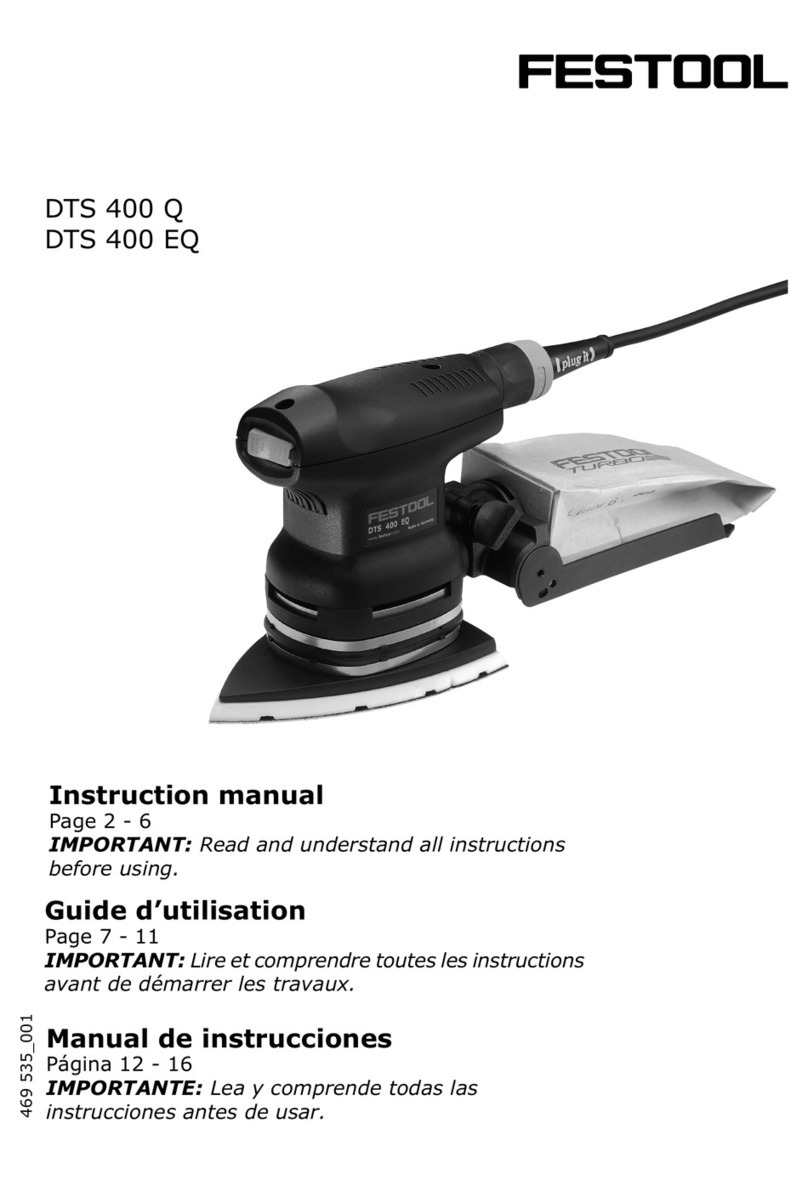
Festool
Festool DTS 400 Q instruction manual
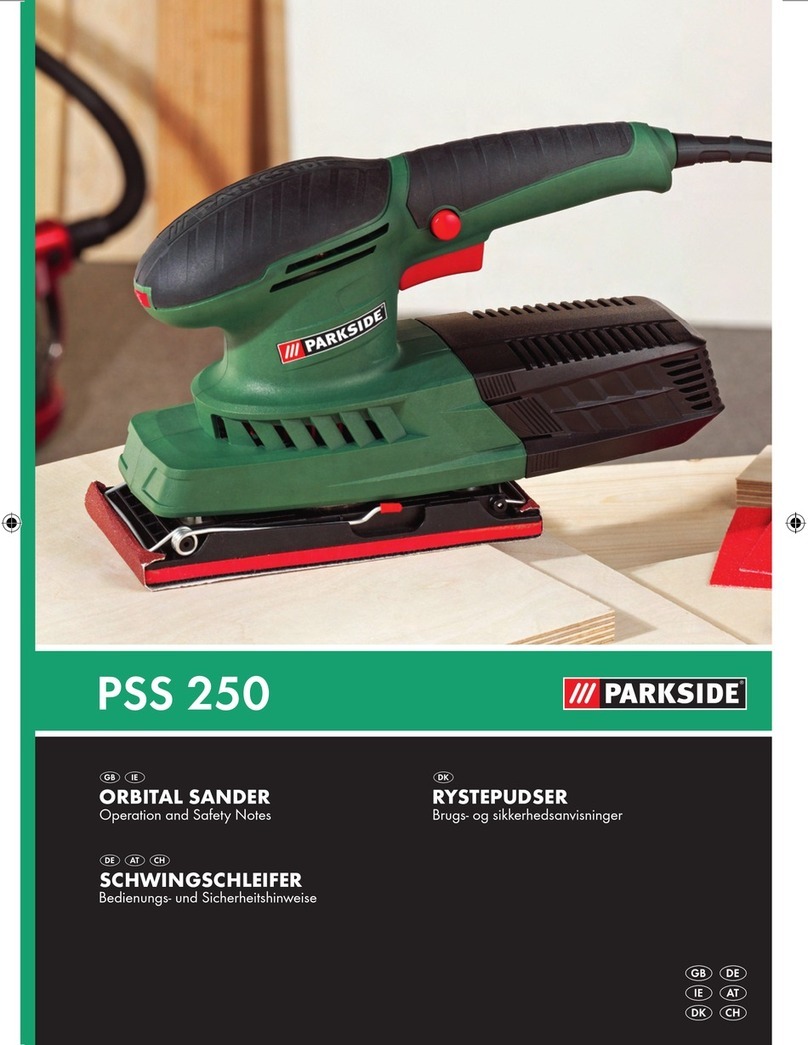
Parkside
Parkside PSS 250 Operation and safety notes
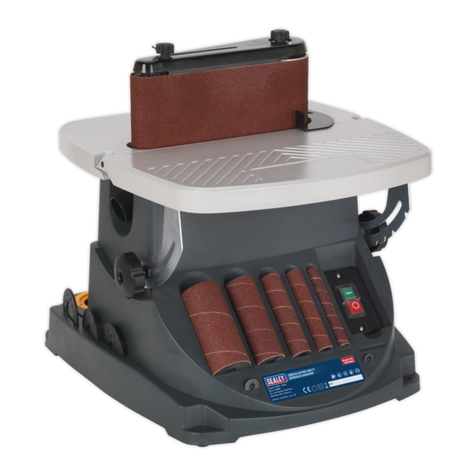
Sealey
Sealey SM1300 quick start guide
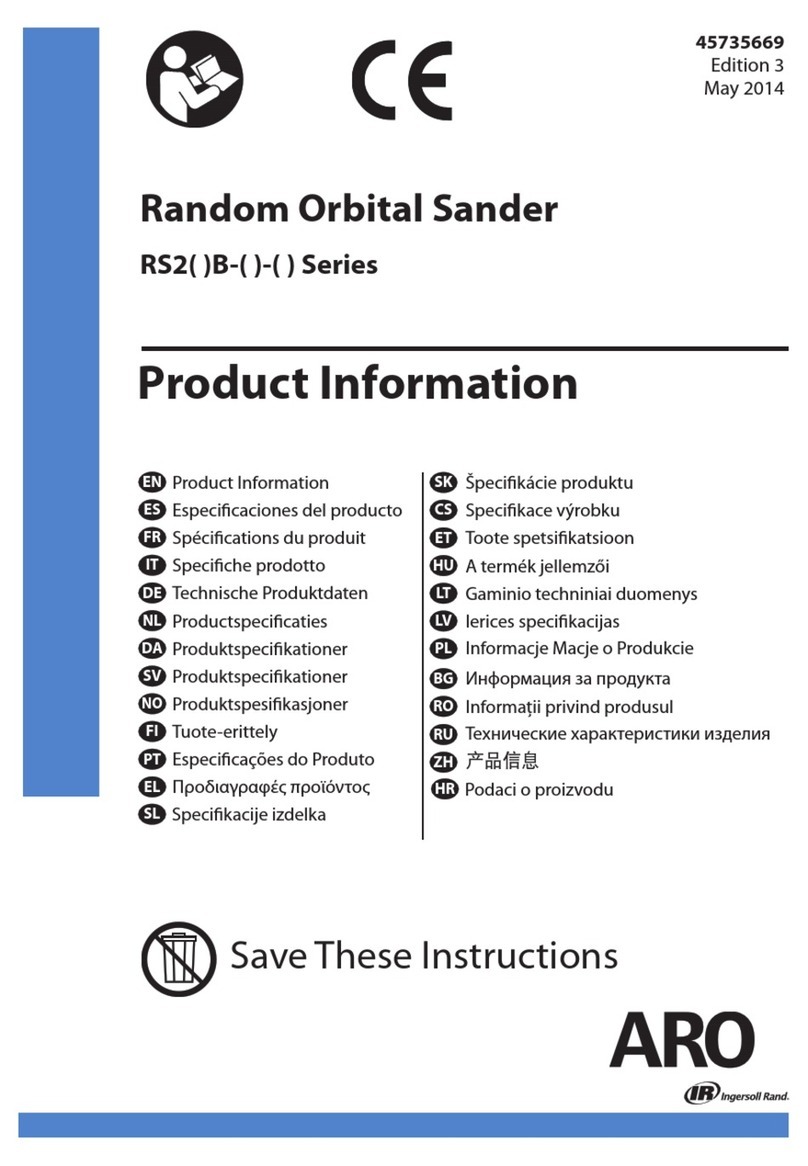
Ingersoll-Rand
Ingersoll-Rand ARO RS2 B Series Product information
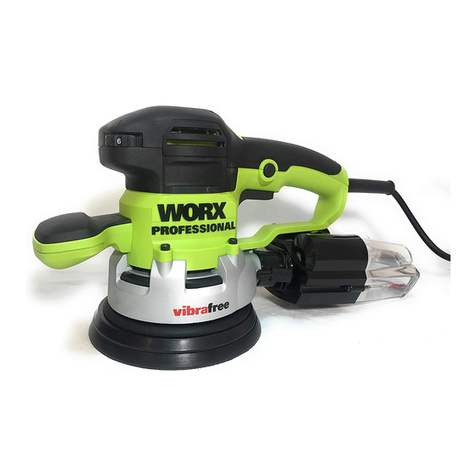
Worx
Worx Professional WU654 Safety and operating manual
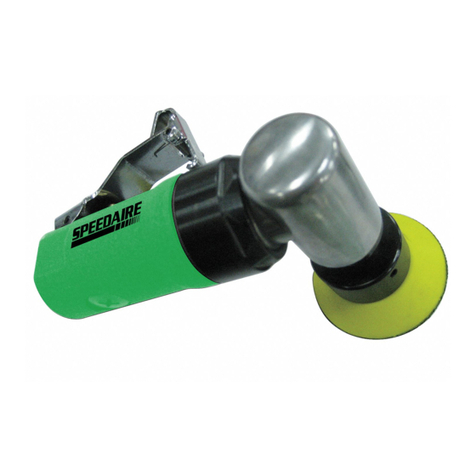
Speedaire
Speedaire 10D233 Operating instructions & parts manual


